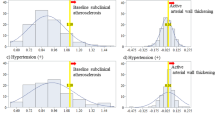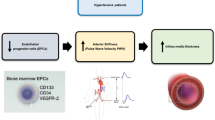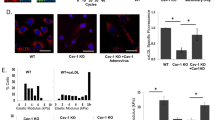Abstract
Reduced arterial elasticity is a hallmark of ageing in healthy humans and appears to occur independently of coexisting disease processes. Endothelial-cell injury and dysfunction may be responsible for this fall in arterial elasticity. We hypothesized that circulating endothelial progenitor cells (EPCs) are involved in endothelial repair and that lack of EPCs contributes to impaired arterial elasticity. A total of 56 healthy male volunteers were divided into young (n=26) and elderly (n=30) groups. Large and small artery elasticity indices were noninvasively assessed using pulse wave analysis. The number of circulating EPCs was measured by using flow cytometry. Cells demonstrating DiI-acLDL and FITC-ulex lectin double-positive fluorescence were identified as EPCs. C1 large artery elasticity and C2 small artery elasticity indices were significantly reduced in the elderly group compared with the young group (11.73±1.45 vs 16.88±1.69 ml/mm Hg × 10, P<0.001; 8.40±1.45 vs 10.58±1.18 ml/mm Hg × 100, P<0.001, respectively). In parallel, the number of circulating EPCs was significantly reduced in the elderly group compared with the young group (0.13±0.02 vs 0.17±0.04%, P<0.05). The number of circulating EPCs correlated with C1 large and C2 small artery elasticity indices (r=0.47, P<0.01; r=0.4, P<0.01). The present findings suggest that the fall in circulating EPCs with subsequently impaired endothelial-cell repair and function contributes to reduced arterial elasticity in humans with ageing. The decrease in circulating EPCs may serve as a surrogate biologic measure of vascular function and human age.
This is a preview of subscription content, access via your institution
Access options
Subscribe to this journal
Receive 12 digital issues and online access to articles
$119.00 per year
only $9.92 per issue
Buy this article
- Purchase on Springer Link
- Instant access to full article PDF
Prices may be subject to local taxes which are calculated during checkout




Similar content being viewed by others
References
Oliver JJ, Webb DJ . Noninvasive assessment of arterial stiffness and risk of atherosclerotic events. Arterioscler Thromb Vascular Biol 2003; 23: 168–175.
Wilkinson IB, Qasem A, McEniery CM, Webb DJ, Avolio AP, Cockcroft JR . Nitric oxide regulates local arterial distensibility in vivo. Circulation 2002; 105: 213–217.
Kinlay S, Creager MA, Fukumoto M, Hikita H, Fang JC, Selwyn AP et al. Endothelium-derived nitric oxide regulates arterial elasticity in human arteries in vivo. Hypertension 2001; 38: 1049–1053.
McVeigh GE, Bratteli CW, Morgan DJ, Alinder CM, Glasser SP, Finkelstein SM et al. Age-related abnormalities in arterial compliance identified by pressure pulse contour analysis; aging and arterial compliance. Hypertension 1999; 33: 1392–1398.
Tao J, Jin YF, Yang Z, Wang LC, Gao XR, Lui N et al. Reduced arterial elasticity is associated with endothelial dysfunction in persons of advancing age: comparative study of laser Doppler measurement and pulse wave analysis. Am J Hypertens 2004; 17: 654–659.
Hibbert B, Olsen S, O'Brien E . Involvement of progenitor cells in vascular repair. Trends Cardiovasc Med 2003; 13: 322–326.
Moldovan NI, Asahara T . Role of blood mononuclear cells in recanalization and vascularization of thrombi: past, present, and future. Trends Cardiovasc Med 2003; 13: 265–269.
Hristov M, Erl W, Weber P . Endothelial progenitor cells: mobilization, differentiation, and homing. Arterioscler Throm Vasc Biol 2003; 23: 1185–1189.
Asahara T, Murohara T, Sullivan A, Silver M, van der Zee R, Li T et al. Isolation of putative progenitor endothelial cells for angiogenesis. Science 1997; 275: 964–967.
Peichev M, Maiyer AJ, Pereir D, Zhu ZP, Land WJ, William M et al. Expression of VEGFR-2 and AC133 by circulating human CD34+ cells identifies a population of functional endothelial precursors. Blood 2000; 95: 952–958.
Vasa M, Fichtlscherer S, Aicher A, Adler K, Urbich C, Martin H et al. Number and migratory activity of circulating endothelial progenitor cells inversely correlate with risk factors for coronary disease. Circ Res 2001; 89: e1–e7.
Hill JM, Zalos G, Halcox JP, Schenke WH, Waclawiw MA, Quyyumi AA et al. Circulating endothelial progenitor cells, vascular function, and cardiovascular risk factor. N Engl J Med 2003; 348: 593–600.
McVeigh GE, Allen PB, Morgan DR, Hanratty CG, Silke B . Nitric oxide modulation of blood vessel tone identified by arterial waveform analysis. Clin Sci 2001; 100: 387–393.
Rauscher FM, Goldschmidt-Clermint PJ, Davis BH, Wang T, Gregg D, Ramaswami P et al. Aging, progenitor cell exhausion, and atherosclerosis. Circulation 2003; 108: 457–463.
Scheubl RJ, Zorn H, Silber R, Kuss O, Morawietz H, Holtz J et al. Age-dependent depression in circulating endothelial progenitor cells in patients with undergoing coronary artery bypass grafting. J Am Coll Cardiol 2003; 42: 2073–2080.
Hu Y, Davision F, Zhang Z, Xu Q . Endothelial replacement and angiogenesis in arteriosclerotic lesion of allografts are contributed by circulating progenitor cells. Circulation 2003; 108: 3122–3127.
Gunsilius E, Duba HC, Petzer AL, Kahler CM, Grunewald K, Stockhammer G et al. Evidence from a leukemia model for maintenance of vascular endothelium by bone-marrow-derived endothelial cells. Lancet 2000; 355: 1688–1691.
Lin Y, Weisdorf DJ, Solovey A, Hebbel RP . Origins of circulating endothelial cells and endothelial outgrowth from blood. J Clin Invest 2000; 105: 71–77.
Author information
Authors and Affiliations
Corresponding author
Rights and permissions
About this article
Cite this article
Tao, J., Wang, Y., Yang, Z. et al. Circulating endothelial progenitor cell deficiency contributes to impaired arterial elasticity in persons of advancing age. J Hum Hypertens 20, 490–495 (2006). https://doi.org/10.1038/sj.jhh.1001996
Received:
Revised:
Accepted:
Published:
Issue Date:
DOI: https://doi.org/10.1038/sj.jhh.1001996
Keywords
This article is cited by
-
Non-coding RNAs regulating endothelial progenitor cells for venous thrombosis: promising therapy and innovation
Stem Cell Research & Therapy (2024)
-
Effects of dulaglutide on endothelial progenitor cells and arterial elasticity in patients with type 2 diabetes mellitus
Cardiovascular Diabetology (2022)
-
Decreased levels and function of circulating endothelial progenitor cells in unruptured intracranial saccular aneurysm patients
Neurological Sciences (2014)
-
Elevated circulating endothelial microparticles and brachial–ankle pulse wave velocity in well-controlled hypertensive patients
Journal of Human Hypertension (2009)
-
Berberine-induced mobilization of circulating endothelial progenitor cells improves human small artery elasticity
Journal of Human Hypertension (2008)



